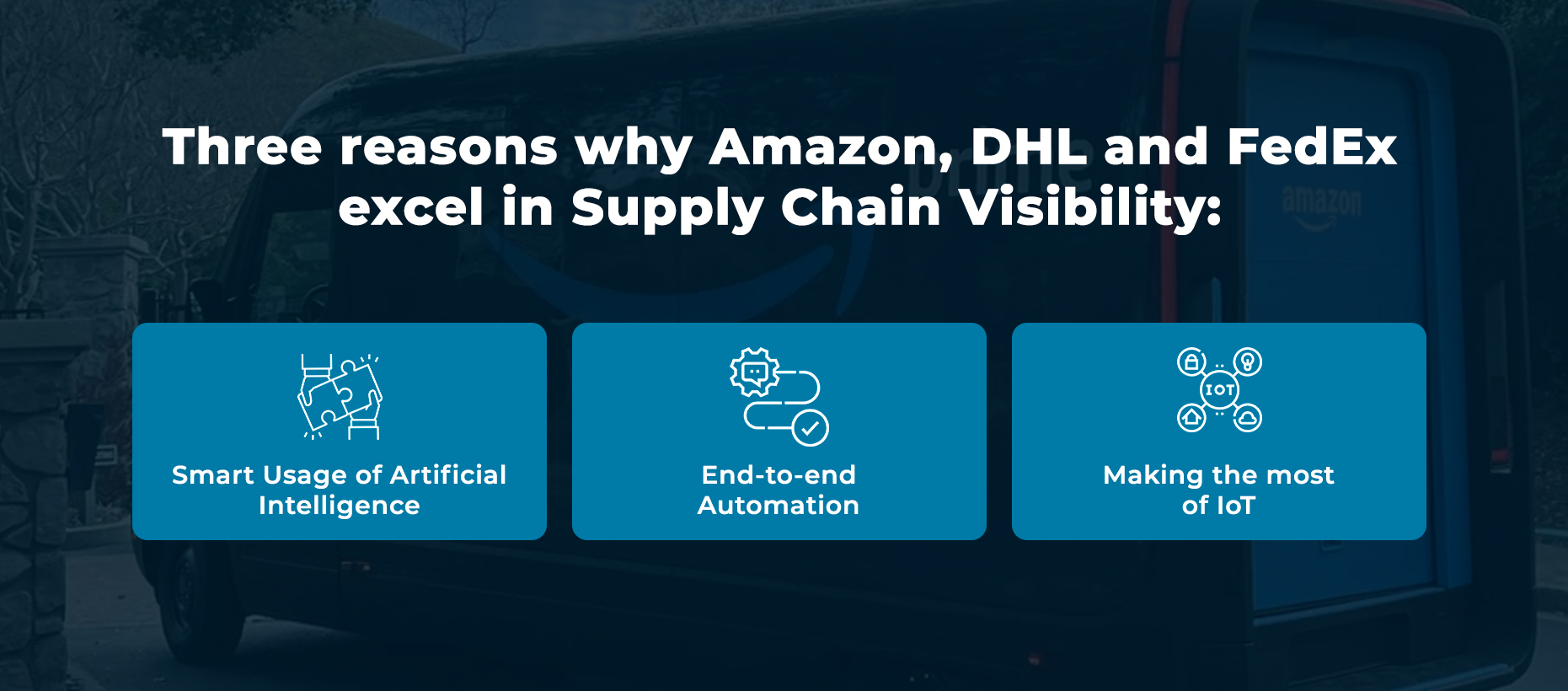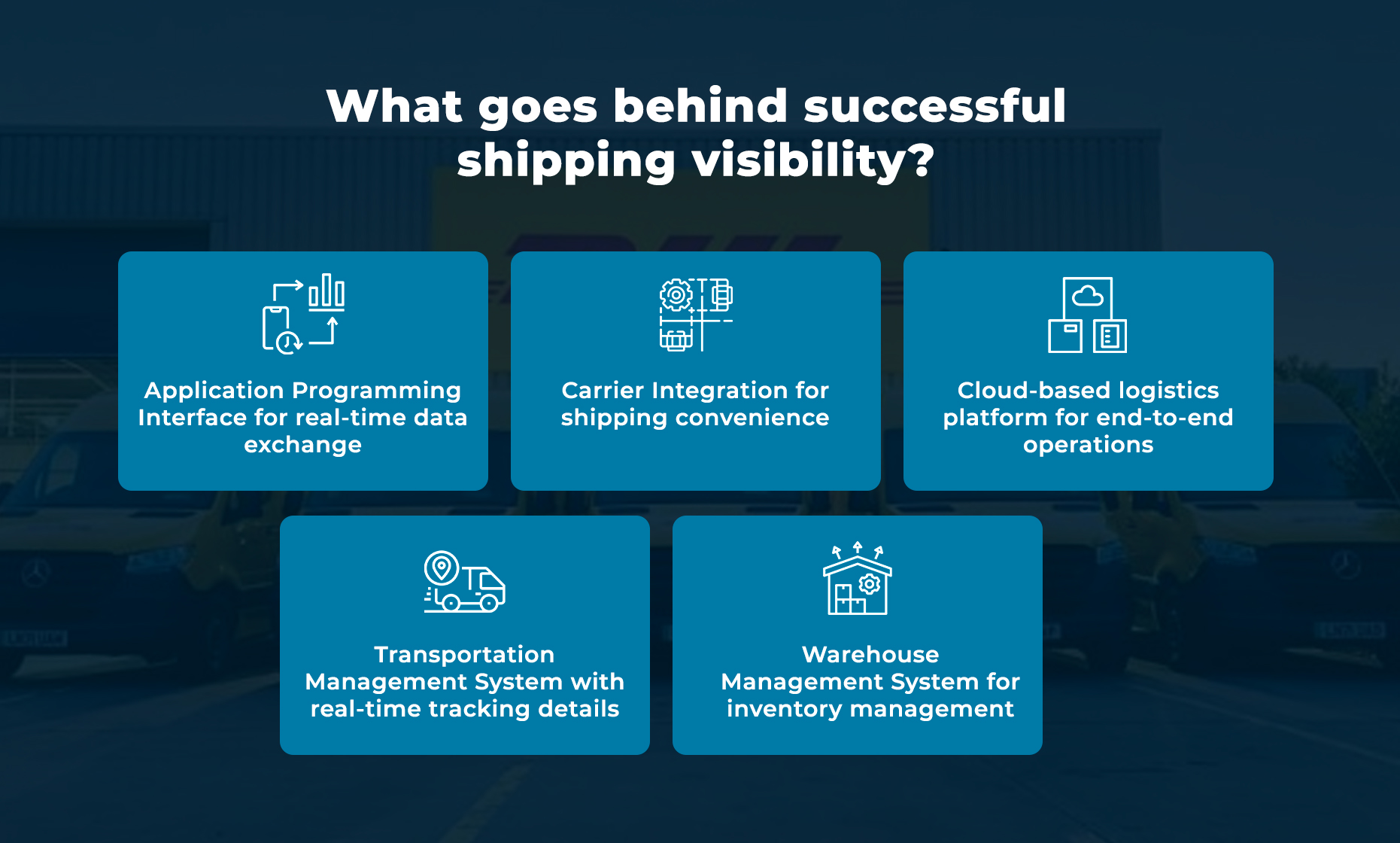Every customer in today’s world expects speedy delivery and visibility into their order along the way. The ongoing process of spearheading the push of end-to-end visibility and transforming the entire supply-chain management was primarily initiated by large players like Amazon and DHL. Meanwhile, various other industries like eCommerce, retail, pharma, and more are also working on improving supply chain visibility to meet their customer expectations. Even in B2B markets, customers have come to expect the level of visibility that Amazon has created.
In this article, let’s talk about giants like Amazon, FedEx and DHL. In addition, let’s understand how do they offer not only offer seamless supply chain visibility but also provide simplicity while processing numerous orders.
Understanding the Importance of Supply Chain Visibility
Supply chain visibility refers to the ability to track and monitor the movement of goods. This happens at every stage of the supply chain, from production to delivery. Most importantly, it enables businesses to identify inefficiencies, mitigate risks, and improve overall performance. Furthermore, transparent and real-time communication fosters trust. Also, it enhances the customer experience, ultimately driving customer satisfaction and loyalty.
Emerging technologies, risks, and customer needs have less influence on the supply chain’s digital strategy than does the enterprise’s digital strategy. Most importantly, 69% of supply chain leaders say that their company is investing in digitalization and expects the supply chain function to adapt.
This is an essential insight that helps us understand the various drivers of value. Also, it helps us identify the right investments, increase productivity, and deliver greater business impact. With this, let’s get going as we talk about big names from the industry. In this article, we’ll understand how their supply chain visibility made them seamless and popular.
Interesting Read: Top 5 Best Supply Chain Visibility Software
What makes the supply chain management of brands like Amazon, DHL, and FedEx stand out?
Everyone knows that Amazon is one of the most customer-obsessed brands in the world. Additionally, DHL and FedEx are the biggest names when it comes to logistics and deliveries. Here’s how they are doing it:

Artificial Intelligence: Major activities in the logistics cycle such as optimization of routes, demand forecast, and focusing on warehouse operations are taken care of with the help of AI.
To offer an example for the same, did you know that UPS uses machine learning algorithms to conveniently predict efficient routes for its drivers and prioritize reducing fuel consumption along with saving time?
Automation: Supply chain managers can now make the most of automation to streamline warehouse operations, improve efficiency, and reduce errors.
Did you know that Amazon’s automated fulfillment centers make use of robots to pick and pack orders? Most importantly, they focus on reducing the time it takes to process an order from hours to minutes.
Also Read: What Logistics Software Does Amazon Use?
Internet of Things: The Internet of Things (IoT), is now used to track inventory and shipments, providing businesses with greater real-time visibility into their supply chain. For example, DHL uses IoT sensors to monitor the temperature and humidity of shipments. It ensures that perishable goods arrive in optimal condition.
Quick Read: Insights From DHL’s Focus On Tech And Innovation
The future of supply chain tracking and visibility:
The foundation of supply chain visibility lies in advanced technology and data analytics. The ones who are not making the most of technology in today’s time will have to suffer sooner or later when it comes to keeping up with the competitors and the market standards. You can always try to leverage data analytics to analyze historical trends and forecast demands. This is a helping parameter in identifying areas for improvement within your supply chain. However, you need to focus on more:
How would you choose technologies that provide insights into inventory levels, shipment status, and potential bottlenecks, allowing you to proactively address issues and optimize operations?
Invest in a robust logistics management system equipped with features such as real-time tracking, predictive analytics, and IoT sensors. IoT and its enabling technologies (including 5G networking) are giving rise to a new era of supply chain visibility.

These intangible assets listed above will help supply chain leaders fully leverage the productivity of digital tools. However, even if all these things are essential to enhance the supply chain visibility, how should one ensure to have all these things in one place? By investing in the correct logistics management software. Moreover, investing in one that works as a TMS, WMS, and supply chain management software.
Choose LogiNext for enhanced visibility for your retail and CPG business:
LogiNext is the one-stop solution for all the logistics needs to ensure that all your customers have a fair understanding of their deliveries. The retail and CPG market is highly fragile and losing a customer to a competitor needs just one small mistake. It can be related to the delivery time, unorganized follow-ups, or anything in between. Wish to consistently increase your customer retention? Here are some things that you can do by choosing LogiNext as your supply chain visibility software:
1. Real-time tracking for every delivery and shipment.
2. Proactive issue resolution from the warehouse to the final delivery destination.
3. Concrete planning and forecasting to ensure safer and faster deliveries.
4. Data-driven decision-making for better customer satisfaction in the present and future.
Wish to know more about how LogiNext can help you with this?
Explore and get started now!
Modern retail is all about playing a key part in a huge supply chain ecosystem. It streamlines transactions between various links within the chain, even as it aligns to the ever-changing consumer demands. The key logistics here is to play the part of an enabler effectively. Further, it also gives the consumer just what he wants. It’s going to be one helluva challenge for retailers to live up to consumer expectations in the coming future. However, it also promises to be an exciting time where technology can give you that extra mile in market advantage. So, if you want to be the next Amazon or Walmart, start now!
12





















